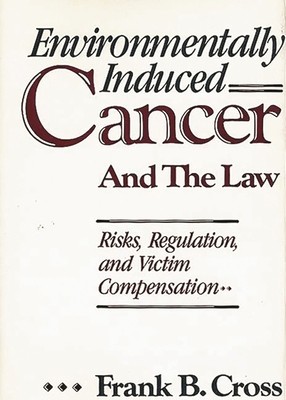
- We will send in 10–14 business days.
- Author: Frank B Cross
- Publisher: Praeger
- ISBN-10: 0899303897
- ISBN-13: 9780899303895
- Format: 16.4 x 24.3 x 2.4 cm, kieti viršeliai
- Language: English
- SAVE -10% with code: EXTRA
Reviews
Description
Frank Cross provides a comprehensive treatment of the widely feared problem of environmentally induced cancer. The author takes a threefold approach to the problem, first examining the cancers themselves and what is known about their causes and then exploring both the government's regulation of these environmental pollutants and the legal remedies available to victims of such cancers. Throughout, new proposals for regulating carcinogens and compensating the victims of environmental cancer are discussed.
In Part I, Cross addresses the significant and unique problems presented by the disease of cancer, demonstrating that the limits of scientific knowledge, the absence of a demonstrable safe threshold of exposure and other special features of the disease create a unique cancer problem for government. The second section examines the various risk-management approaches from which a regulatory agency may choose. As Cross demonstrates, government must identify carcinogens, assess the risks they present, and choose control methods--a complex task made even more difficult by the conflicting claims of industry and environmental groups. He concludes this section by proposing future approaches for more effective regulation, including prioritization of the greatest hazards and adoption of a moderate, feasibility-based control program. The final chapters explore legal obstacles to victim compensation and argue for fundamental changes in existing common law doctrines to enhance the ability of victim/plaintiffs to recover adequate damages.
EXTRA 10 % discount with code: EXTRA
The promotion ends in 21d.19:22:45
The discount code is valid when purchasing from 10 €. Discounts do not stack.
- Author: Frank B Cross
- Publisher: Praeger
- ISBN-10: 0899303897
- ISBN-13: 9780899303895
- Format: 16.4 x 24.3 x 2.4 cm, kieti viršeliai
- Language: English English
Frank Cross provides a comprehensive treatment of the widely feared problem of environmentally induced cancer. The author takes a threefold approach to the problem, first examining the cancers themselves and what is known about their causes and then exploring both the government's regulation of these environmental pollutants and the legal remedies available to victims of such cancers. Throughout, new proposals for regulating carcinogens and compensating the victims of environmental cancer are discussed.
In Part I, Cross addresses the significant and unique problems presented by the disease of cancer, demonstrating that the limits of scientific knowledge, the absence of a demonstrable safe threshold of exposure and other special features of the disease create a unique cancer problem for government. The second section examines the various risk-management approaches from which a regulatory agency may choose. As Cross demonstrates, government must identify carcinogens, assess the risks they present, and choose control methods--a complex task made even more difficult by the conflicting claims of industry and environmental groups. He concludes this section by proposing future approaches for more effective regulation, including prioritization of the greatest hazards and adoption of a moderate, feasibility-based control program. The final chapters explore legal obstacles to victim compensation and argue for fundamental changes in existing common law doctrines to enhance the ability of victim/plaintiffs to recover adequate damages.


Reviews